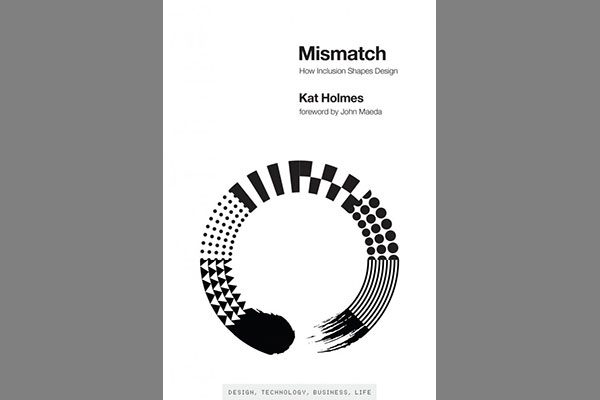
Author: Kat Holmes (The MIT Press, 2017)
The idea of universal design is powerful and (hopefully) prevalent in everything designers do. As I read Kat Holmesã Mismatch: How Inclusion Shapes Design, however, I realized that too often designers rely on generalizations across many dimensions of design-thinking, ultimately resulting in sterilized solutions befitting of both everyone and no one.ô Mismatch is a short look at ways that people feel excluded through design.
Holmes opens the book focusing on in-group/out-group mentalities, arguing that inclusivity is possible through inclusive design processes. She follows a ãWho, What, Why, When, Howã model that serves her thesis well.
Mismatchô pleasantly meanders around all types of designãfrom architecture to product designã using anecdotes and interviews alongside research to support Holmes’ perspective. As I moved through the book, I was initially inspired and energized by the stories I readãlike one of a gamer/UX designer in a wheelchair who uses his voice to engage the world, who was struggling to use the controllers designed for able-bodied people and who triumphed over these challenges through smart design.
With this in mind, Holmes speaks well to what she calls “the spectrum of permanent, temporary, and situational mismatches that people experience based on their abilities and disabilities.” Thus,ô while one may design something for someone who has one arm (permanent), he/she should also consider the person with a broken arm (temporary) or with a baby in their arms (situational).
This was one of the most powerful aspects of the book for me as a designer as, too frequently, designers create areas that “work for everyone.” If there are special considerations, they are often planned for based on regulations such as building codes (i.e. for accessibility). Too rarely are aspects of daily life thought of comprehensively across different experiences. So, design considerations around how someone withô hand mobility issues would open a door can, and should, extend to consider others who cannot use both their hands for different reasons, such as carrying children.
Where some readersãdesign practitioners, in particularãmay take issue, however, is in theô We Are All Designers section of the 4th Chapter where Holmes states:
The traditional design professionals are rapidly changing, especially in areas of technology where the required skills change so quickly that many universities are struggling to maintain a relevant curriculum. Much of today’s design work isnãt limited to people with the word ãdesignã in their professional titles.
Those in the field understand the challenge behind this statement. The design disciplines have legislating bodies fighting for practice acts, and intensive schooling and aptitude testing to ensure that all practitioners are meeting a high standard for industry practice. As such, her call to open the doors towards more design inclusivity in this way requires critical reflection on ensuring not to undermine the important structures currently in place that serve to ensure high-quality work.
I, personally, believe that everyone is capable of design-thinking, but the ability to apply that knowledge properly and safely is through proper education and practice. We should strive for more inclusivity by attracting people with a greater diversity of backgrounds and experience into those educational and practice channels that have safety, healthy environmental design in mindãespecially in areas like Architecture, Urban Planning, Interiors, and Landscape Architecture as these areas have a rich bodies of knowledge and traditions.
Overall,ô Mismatch: How Inclusion Shapes Designô was an enjoyable read, and truly a call to arms for designers to look past the norm. Designers have effectively left certain people out of the design conversation, and we need to bring them back into the fold. But we must do so safely, and with proper oversight.
***
For more information onô Mismatch: How Inclusion Shapes Design, visit the MIT Press website.
**
Jeremy Senkoô is happily lost in the world of theoretical architecture and design. He is forever a student at heart, consistently reading, experiencing and learning about the world he inhabits. More specifically, he recently completed his Bachelor of Interior Design at Kwantlen Polytechnic University, where he pushed the limits (and the patience) of his professors.


